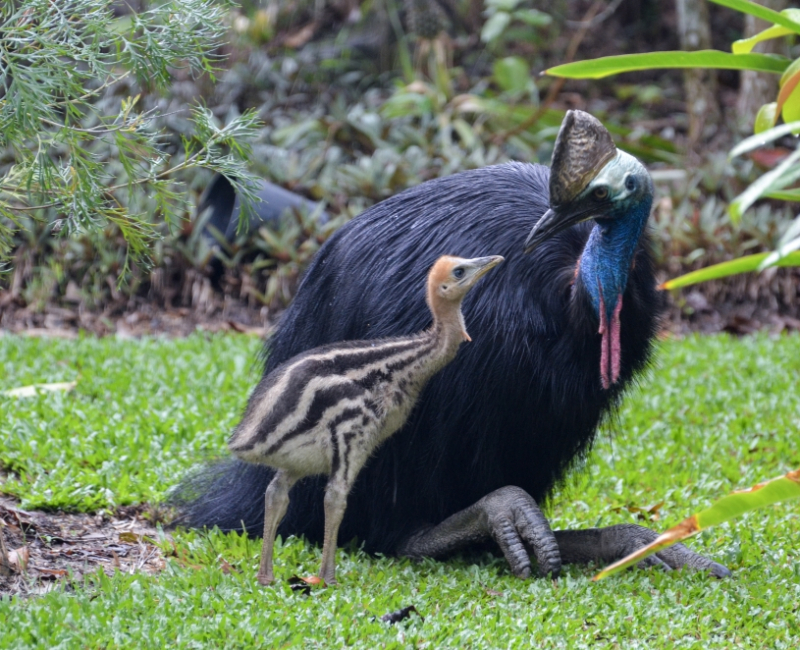CASSOWARY FAQS
Cassowary FAQs
How do I report a Cassowary sighting? Who do I call to help an injured Cassowary? Are Cassowaries dangerous to humans? Are Cassowaries related to dinosaurs? What is that thing on top of their heads? Find these answers and more within our Cassowary FAQs
Have some Cassowary FAQs that are not answered below? Contact us and we’ll do our best to find the answers and add them to the list.
To report a non-urgent sighting (where immediate assistance is not required) please send sighting information i.e., when (date), where, what time, how many, and what they were doing to Jeff Larson of C4 (larsonjeff86@gmail.com).
You can also share information about sightings in the Mission Beach area via the Mission Beach Cassowaries group on Facebook or by filling in the sightings log at the C4 visitor centre. For more contacts at C4 click here.
The Daintree Region Cassowary Group would love information about sightings in the Daintree and Cape Tribulation area. Click on the “Submit Sighting” link on the front page of their website and complete the online form.
You can also submit sighting information to Kuranda Conservation Community Nursery and non-urgent reports to DES via their online contact form.
If you see a cassowary in trouble and in urgent need of assistance such as an injured cassowary an orphaned chick, or a cassowary in clear distress (e.g. sick or starving), please call the 24-hour DES hotline 1300 130 372.
After hours, this number goes to the Northern Region Duty Officer at the Wildlife Management Unit. If your call goes to voicemail, please leave a message with as much detail as possible about the incident, location, timing, and contact details so that local rangers or wildlife carers are able to respond appropriately.
You can also call the hotline if you see a cassowary crossing the road and there is a need for temporary Cassowary Crossing signs to be erected. Choose the injured cassowary option.
If you see a cassowary in trouble and in urgent need of assistance such as an injured cassowary an orphaned chick, or a cassowary in clear distress (e.g. sick or starving), please call the 24-hour hotline 1300 130 372.
After hours, this number goes to the Northern Region Duty Officer at the Wildlife Management Unit. If your call goes to voicemail, please leave a message with as much detail as possible about the incident, location, timing, and contact details so that local rangers or wildlife carers are able to respond appropriately.
You can also call the hotline if you see a cassowary crossing the road and there is a need for temporary Cassowary Crossing signs to be erected. Choose the injured cassowary option.
To report a non-urgent sighting (where immediate assistance is not required) please send sighting information i.e., when (date), where, what time, how many, and what they were doing to Jeff Larson of C4 (larsonjeff86@gmail.com).
You can also share information about sightings in the Mission Beach area via the Mission Beach Cassowaries group on Facebook or by filling in the sightings log at the C4 visitor centre. For more contacts at C4 click here.
The Daintree Region Cassowary Group would love information about sightings in the Daintree and Cape Tribulation area. Click on the “Submit Sighting” link on the front page of their website and complete the online form.
You can also submit sighting information to Kuranda Conservation Community Nursery.
Please DO NOT feed the cassowaries. Cassowaries need to be foraging for their own food in the rainforest and not waiting for a feed of chopped fruit (or other food that is not species-appropriate) in our urban areas.
Cassowaries can become used to hand-feeding, thus increasing their exposure to the risks posed in developed areas, such as vehicle strikes and dog attacks. Following cyclones, the Queensland Parks & Wildlife Service organises feeding in a manner that is safe for both birds and people. If you’re living with cassowaries in your area or visiting Cassowary Country, please dispose of food rubbish safely and secure your compost bin to prevent ‘raids’ by cassowaries and other wildlife.
Deliberately feeding cassowaries (and other native wildlife) is illegal under Queensland law and has a maximum penalty of $6,452
You can report deliberate cassowary feeding to the Department of Environment and Science (DES) on 1300 130 372 or via their online contact form.
The Southern Cassowary is a large, flightless rainforest bird, with black, two shafted, hair-like feathers, large powerful feet and legs, a colourful head and neck and a helmet-like structure called a casque atop its head. Its scientific name (species binomial) is Casuarius casuarius johnsonii and denotes that our Australian bird is a subspecies of the PNG nominate species. Cassowaries are members of the ratite family, which includes their closest relative the emu, the 5 species of New Zealand’s Kiwis, Africa’s two species of Ostrich and South America’s two species of Rheas.
Southern Cassowaries live in the tropical rainforests of Far North Queensland. Two populations live in the north of Cape York in the Jardine and Iron Range areas, and a larger population lives further south in the Wet Tropics, between Cooktown and Townsville. Read more about the Cassowary’s ecology and habitat here.
Three species of Cassowary exist in the world today. West Papua and Papua New Guinea (PNG) have all three species. To the north is the Single Wattled or Northern Cassowary (Casuarius unappendiculatus). In the highlands is the smaller Dwarf Cassowary (Casuarius bennetti) and towards the south is the largest species the Two Wattled or Southern Cassowary (Casuarius casuarius). In Australia, we have a distinctive subspecies of the Southern Cassowary (Casuarius casuarius johnsonii).
Southern Cassowaries are frugivores, which means that they mainly eat fruit. The majority of their diet is made up of fleshy rainforest fruits some of which are quite large. Cassowaries do not have a tongue and must toss food with their beaks to back of their throats to allow them to swallow. Cassowaries prefer fallen fruits but have also been observed eating low-hanging fruits from shrubs and trees and have also been observed jumping up to pluck fruits from tree trunks and branches. Southern Cassowaries eat the fruit of over 240 rainforest trees, shrubs and climbers, they include plants such as the Blue Quandongs, Cassowary and Davidson Plums and a host of Laurels. Cassowaries don’t just eat fruits, they also consume other foods such as plant leaf matter, fungi, carrion, as well as insects, snails and small animals such as lizards and rodents.
Adult cassowaries are solitary for most of the year and tend to avoid each other. However, during the breeding season (May – November) females will seek out males to form courting pairs. Female cassowaries are much larger than males and are the dominant sex. As in many ratites, the male bird is the sole care provider for the eggs and chicks. After mating, the female will lay an average of four eggs which she will leave in the care of the father. The female may then seek another mate. The male bird will incubate the eggs for around 50 days and then look after his chicks for around 9 months, by which time the next breeding season has arrived. Cassowaries may also be seen in small groups at times of food abundance or scarcity, to take advantage of available food sources.
The helmet-like structure on a cassowary’s head is called a casque and is what brought about their common name. “Kasu” in Papuan means “horned” and “weri” means “head”. The inside of the casque is honeycombed and spongy and connected to ear canals, while the outer layer is usually light to dark brown in colour and resembles the material found on a turtle shell. Each cassowary has a unique casque which can be used to identify individual birds. Some scientists believe that the casque is a receptor of sound for low-frequency vocalisations, which allow cassowaries to communicate over long distances in their dense rainforest homes, while others have suggested it may reveal a bird’s age or dominance, or be used as a sort of helmet or shock absorber. Researchers at La Trobe University published new evidence in February 2019, showing that the casque acts as a thermal window to help the large, flightless birds keep cool in hot weather. Read more about these findings here.
In 1988 survey of the Wet Tropics cassowary population estimated that between 2500–4000 adults existed but a later survey had a slightly higher figure. Regardless of the exact number, they remain a species that continues to need our help to survive.
Cassowaries make a range of noises, including hissing, rumbling, coughing and booming noises. Cassowaries may not vocalise frequently when they do the main purposes are probably to attract and court a mate during the breeding season, to warn other cassowaries of their presence, and for family communication between fathers and chicks. Like most young birds, cassowary chicks are known to chirp or whistle to communicate with Dad. Cassowaries have been recorded making very low-frequency, booming calls, at the lowest end of human hearing. These low-frequency noises are referred to as infrasound and are thought to allow communication over long distances through the dense rainforest foliage (Mack & Jones, 2003). These booming calls have been described as strange and unsettling by humans who have been lucky enough to witness them. These are the lowest known vocalisations of all birds. Elephants are also known to communicate with infrasound. Emus, the closest relatives of the cassowaries, make similar booming calls that can be heard over long distances. The cassowary’s casque may assist the birds by acting as an amplifier or receiver for this infrasound communications.
Cassowaries play a very important ecological role in the tropical rainforests of Far North Queensland. It is a “Rainforest Gardener”, one of the most important seed-dispersing species in these ecosystems. Their main food is rainforest fruits, and the gentle treatment of these fruits in the cassowary’s digestive system means that the seeds are passed unharmed and ready for germination in their own “compost heap” of dung. Cassowaries are the only native animal capable of dispersing the seeds of large-fruited shrubs, vines and trees over long distances, ensuring the continued balance and biodiversity of the rainforest plant community. Without cassowaries assisting with seed dispersal, these plants and trees would only occur in concentrated pockets around parent trees or in places where dispersal by gravity can occur, such as gullies or the bottom of slopes. The Cassowary ensures the continued balance and biodiversity of the rainforest for all the animals that live there. Read more about the Cassowary’s ecology and habitat here.
The name cassowary is derived from two Papuan words, kasu (meaning ‘horned’) and weri (meaning ‘head), in reference to the bird’s distinctive casque.
Cassowaries have a perhaps undeserved reputation as a dangerous bird. Due to their large size and the dagger-like claw on their inner toes, they have the ability to cause injury if provoked and, like all wild animals, should be treated with caution and respect and not be approached. 75% of all attacks on humans by cassowaries in Australia involved birds that had previously been fed by humans. Hand-feeding wild animals can alter their behaviour and reduce their natural cautiousness towards humans, increasing risk to both the animals and people. 22% of incidents involved cassowaries acting either in self-defence or defending their chicks. Read about Living with Cassowaries here.
Yes!
All modern birds are descended from a group of bipedal (walking on two legs), mainly carnivorous dinosaurs known as ‘theropods’. Many features we associate with modern birds, such as feathers, hollow bones, nesting, egg-brooding and care for young first appeared in this group of dinosaurs. Ratites are one of the oldest lineages of modern birds, and cassowaries share similarities with some theropod dinosaurs such as the structure of their feet and respiratory systems. The male parental care common to most ratites is also thought to have originated in theropods. Read more about the evolution of Cassowaries here.
Cassowaries lack some anatomical structures associated with bird flight, such as a keel bone to which flight muscles attach. While they do have wings, they are small and rudimentary. Their feathers are also not suitable for flying and their large size makes it extremely unlikely that they would be able to fly anyway. Losing the ability to fly allowed cassowaries and their ratite relatives such as ostriches and emus to attain a large size.
Unfortunately, an increasing human population in the Australian Southern Cassowary’s home has had a serious impact on these magnificent birds. Habitat loss and fragmentation due to human activities are the main threats to Queensland’s cassowaries as they can separate cassowary populations, reduce food availability and increase their exposure to other threats. Roads divide cassowary home ranges. Crossing roads puts cassowaries at risk of vehicle strikes. Roads can also increase the distance cassowaries must travel for freshwater and fruits. Vehicle strikes are the leading cause of mortality for cassowaries in Australia. Attacks on cassowaries by uncontrolled domestic and feral dogs are the second leading cause of death after car accidents. Hand-feeding alters the natural behaviour of cassowaries and can lead to dangerous inter-species interactions. Disease and natural disasters such as cyclones affect cassowaries at an individual and population level.
Save The Cassowary is not a single-species conservation campaign but aims to continue Rainforest Rescue’s important work in preserving and protecting rainforests forever. The Southern Cassowary has been chosen as an ambassador species to represent the tropical rainforest ecosystems of Far North Queensland. It is an umbrella species.
Due to the vital role Cassowaries play in maintaining the balance and species diversity of rainforest vegetation, their extinction could have a devastating effect for other rainforest dwellers. Many rainforest trees that are dependent upon the Cassowary for seed dispersal would gradually reduce in range and frequency with potentially devastating consequences.
If you live in or are visiting a cassowary area please see our page Living With Cassowaries for tips on ensuring a safe experience for both you and these special birds. If you would like to help Rainforest Rescue’s work to Protect Rainforests Forever and conserve cassowary habitat, check out our Cassowary Care Package Gift Cards or make a donation today.
Have some Cassowary FAQs that are not answered above? Contact us and we’ll do our best to find the answers and add them to the list.
Want to learn more about these incredible birds?
Who am I? The Endangered Southern Cassowary
Ecology & Habitat – The Rainforest Gardener
Indigenous Cultural Significance
Roles of Zoos and Captive Management


DONATE NOW
When you give generously, you become part of a committed team of individuals who collectively are helping to preserve some of the most biodiverse habitats and the species that live within them on this planet. Become a Rainforest Rescuer today!
purchase
and
protect
>>>
and
protect
>>>


